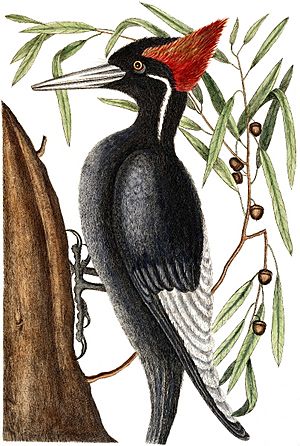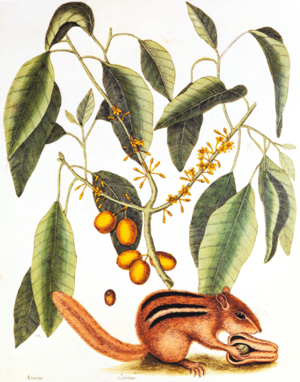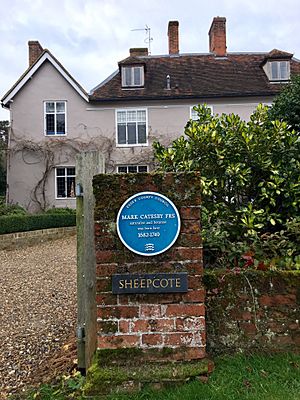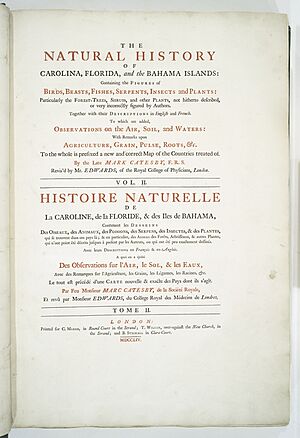Mark Catesby facts for kids
Quick facts for kids
Mark Catesby
|
|
|---|---|
| Born | 24 March 1683 Castle Hedingham, Essex, England
|
| Died | 23 December 1749 (aged 66) London, England
|
| Known for | Natural History of Carolina, Florida and the Bahama Islands |
| Spouse(s) | Elizabeth Rowland |
| Children | Six (at least) |
| Parents |
|
| Scientific career | |
| Fields | Naturalist (both flora and fauna) and artist |
| Patrons | Peter Collinson |
| Influences | John Ray, William Sherard |
| Influenced | Carl Linnaeus |
Mark Catesby (born March 24, 1683 – died December 23, 1749) was an English naturalist. A naturalist is someone who studies nature, including plants and animals. Catesby explored and studied the plants (flora) and animals (fauna) of the New World.
Between 1729 and 1747, Catesby published his famous book, Natural History of Carolina, Florida and the Bahama Islands. This was the first detailed book about the plants and animals of North America. It contained 220 amazing pictures of birds, reptiles, amphibians, fish, insects, mammals, and plants.
Contents
Mark Catesby's Early Life and Travels
Mark Catesby was born on March 24, 1683, in Castle Hedingham, England. His father, John Catesby, was a local politician and farmer. Mark became interested in nature because he knew a famous naturalist named John Ray.
In 1712, Catesby traveled to Williamsburg, Virginia, in America. He went with his sister Elizabeth, whose husband worked for the government there. During this trip, Catesby also visited the West Indies in 1714. He returned to Virginia before going back home to England in 1719.
Collecting Plants and Animals
While in Virginia and Jamaica, Catesby collected many seeds and plant samples. He sent these back to scientists and gardeners in England. He also gave seeds to people like Thomas Fairchild, a nurseryman, and Peter Collinson.
Because of his plant collections, Catesby became well-known in England. In 1722, a group called the Royal Society asked him to go on another trip. This time, he would collect plants in Carolina.
From May 1722, Catesby lived in Charleston, South Carolina. He explored different parts of the colony, gathering plants and animals. He sent his preserved samples to important scientists like Hans Sloane. Catesby helped introduce many new plants, like the Catalpa bignonioides tree, to Europe. He returned to England in 1726.
Creating the Natural History Book
Catesby spent the next 20 years working on his book, Natural History of Carolina, Florida and the Bahama Islands. People who supported his work, called "Encouragers," helped pay for the book. He even learned how to etch the pictures onto copper plates himself.
The first pictures in his book only showed animals. But later, he started drawing plants with the animals. He finished the first part of his book in 1729 and showed it to Queen Caroline. The first full volume was ready in 1732.
Recognition and Later Works
In February 1733, Mark Catesby became a member of the Royal Society. This was a big honor for a scientist. The second volume of his book was finished in 1743. In 1747, he added a special section with new materials sent by friends in America.
Not all the pictures in his book were drawn by Catesby himself. Some, like the beautiful Magnolia grandiflora, were drawn by another artist named Georg Ehret. Catesby's original drawings are now kept at Windsor Castle.
In 1747, Catesby gave a speech to the Royal Society about "birds of passage." He was one of the first people to describe how birds migrate, or travel long distances, each year.
Mark Catesby married Elizabeth Rowland in 1747. They had at least six children together. He passed away on December 23, 1749, in London. His grave is no longer known. After he died, two more of his books about plants were published.
Influence on Other Scientists
The famous Swedish naturalist Carl Linnaeus used information from Catesby's Natural History in his own important book, Systema Naturae (1758). Linnaeus created the system we still use today to name plants and animals.
Mark Catesby's Legacy

Mark Catesby left a lasting mark on the world of science. His detailed work helped others learn about the amazing plants and animals of North America.
Plants and Animals Named After Catesby
Several plants and animals have been named in honor of Mark Catesby. This is a common way to remember important scientists.
- The plant genus Catesbaea, also known as lilythorn, was named after him. These thorny shrubs are found in the West Indies and southeastern USA.
- The American bullfrog, known scientifically as Lithobates catesbeianus, is also named for Catesby.
- Two species of New World snakes, Dipsas catesbyi and Uromacer catesbyi, also carry his name.
See also
 In Spanish: Mark Catesby para niños
In Spanish: Mark Catesby para niños
- List of wildlife artists




